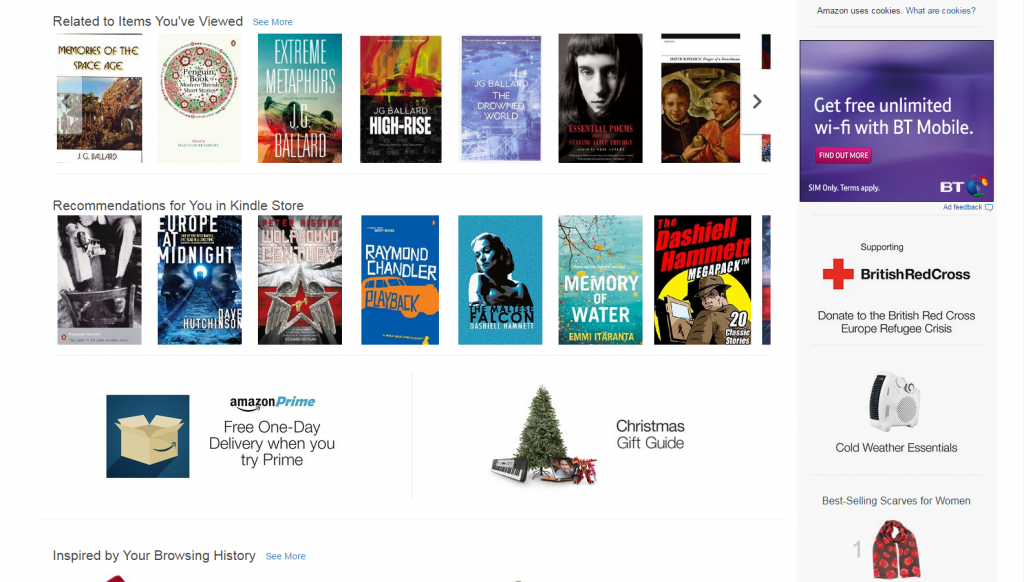4 key stats that prove personalisation is a must have for every business
Are you making a personal connection with your customers? We’ve already looked at ways small businesses can use a bit of personality to get an advantage over their bigger rivals. But what about personalisation? The web offers businesses of all sizes the opportunity to present existing and potential customers with an experience tailored to their needs. Why is that desirable? In this article we’ll look at a range of statistics that show why businesses of all sizes can benefit from personalisation.
So what is personalisation?
You’ll have undoubtedly visited a website that uses personalisation, even if you didn’t realise it at the time. One of the most obvious examples of this technique being used is Amazon’s “related to items you’ve viewed” section.
Does it work? Well we can’t tell precisely how much Amazon makes through its suggestions, but given that it’s one of the largest online retailer around, we can be sure it’s doing something right. Personalisation helps set Amazon apart from its rivals, and it keeps customers coming back for more.
What else do you need to know about personalisation?
Now you might be thinking that just because Amazon does something, that doesn’t mean it’s right for your business. For example, you may not sell a product or you might even be concerned that implementing personalisation will take too much time, money or effort. The following stats should help convince you that personalisation has the potential to help boost your business.
Customers hate irrelevance
Research by Janrain shows that 74% of people get frustrated when a website contains content that has nothing to do with their interests. Obviously if someone is frustrated by your website, they’re going to be less likely to buy from you. You want to make your website as appealing as possible. By providing a personalised experience, you’ll be more likely to show visitors content that’s right for them. That means they’ll be less likely have a frustrating experience with your website and will be more likely to buy from you.
People like personalisation
Just because people dislike irrelevant content, it doesn’t necessarily follow that they like personalisation. We need further stats to reach that conclusion. Which is why O2’s Rise of Me-Tail study is so interesting. It found that over 50% of consumers would be more likely to buy from a business if it was tailoring things to their individual needs. It also suggested that personalisation could lift sales by as much as 7.8%. It’s clear then that personalisation is something that people actively want to see.
Personalisation encourages people to buy more
Research by MyBuys found that 52% of shoppers buy more when retailers use cross-channel personalisation. What does that mean in non-marketing speak? Well, it means customers end up buying more when personalisation extends beyond just a business’s website and into other things such as email marketing. Remember the Amazon example from earlier? Amazon doesn’t just personalise its website. If you’ve shopped with them you’ll no doubt have received personalised emails suggesting products you might be interested in. The MyBuys research shows that this combined approach to personalisation pays off. If you want to learn more about email marketing personalisation specifically and email marketing in general, then check out this guide.
Personalisation really does lift sales
We’ve already seen one statistic indicating personalisation can lift sales and a study by Monetate/Econsultancy adds further evidence. It found in-house marketing teams who are implementing website personalisation had seen a 19% increase in sales. Agencies reported a 21% increase in sales. Imagine that – the chance to boost your sales by a fifth. Of course, there’s no guarantee personalisation will boost your sales by that much. The point is, if you don’t try personalisation then you’ll never know what impact it could have on your business.
So how can you get started with personalisation?
Personalisation may seem like an advanced concept beyond the reach of small business owners, but in fact there are easy ways to get employ the kind of personalisation that big businesses are using. The 123-reg Website Builder allows you to personalise someone’s experience of your website based on a range of factors, including the device they’re using, where they’re located and the date of their visit. We’ll look more at how you can use the Website Builder to deliver a personalised experience for visitors in the next article in this series.


